Main Points:
- XRP ETF Application Gains Attention: Institutional interest may surge if approved, potentially benefiting Ripple’s positioning.
- Rising Bitcoin Mining Costs: Increased costs pose profitability challenges for miners, risking network security if hash rates fall.
- Pension Funds Eyeing Bitcoin: Diversification with Bitcoin in pension portfolios highlights a shift in traditional investment strategies.
XRP ETF Application: A Boost for Ripple and Institutional Investment
Ripple’s application for an XRP ETF has set off waves in the cryptocurrency market, as institutional investors consider the potential for regulated, easy access to XRP. Exchange-Traded Funds (ETFs) are investment funds comprising multiple assets, providing a diversified investment opportunity for general investors. If the XRP ETF is approved, institutional investment in XRP could accelerate, strengthening Ripple’s market presence. Traditionally, cryptocurrencies have faced hurdles due to high volatility and regulatory ambiguities, limiting institutional participation. However, the growing adoption of crypto-related services by major financial institutions underscores a shift in institutional attitudes. XRP’s potential as an ETF may create a safer, more accessible channel for institutional investors, fostering market activity. Approval is a meticulous process, often subject to rigorous scrutiny from regulatory authorities. The regulatory environment and market dynamics will be instrumental in determining the outcome.
Bitcoin Mining Faces Profitability Crisis Amid Rising Costs
The Bitcoin mining industry is grappling with increased costs. Rising electricity prices and the need for advanced mining equipment are escalating expenses, which could impact miners’ profitability. Bitcoin mining involves computational power to validate transactions, with miners consuming massive amounts of energy. Recent global energy price hikes have substantially raised mining costs. Additionally, as mining equipment evolves, there’s pressure to upgrade to remain competitive, which requires significant upfront investments. Decreased profitability may lead some miners to exit, potentially lowering the hash rate and affecting network security. A lower hash rate could make the network more vulnerable to attacks. Although a Bitcoin price increase could offset these challenges, the volatility inherent in crypto markets doesn’t guarantee sustained price growth. The industry is now focusing on cost-reduction strategies and exploring alternative revenue streams to navigate these obstacles.

Pension Funds’ Bold Move Towards Bitcoin Investment
In a notable shift, pension funds traditionally invested in stable assets are now exploring Bitcoin, a high-risk, high-return asset. Typically, pension funds prioritize long-term, stable returns, often favoring stocks or bonds. However, the extended low-interest rate environment has made higher returns appealing, leading pension funds to consider cryptocurrencies. Bitcoin, with its rapid value appreciation over recent years, is now seen as a potential addition for portfolio diversification and long-term gains. Although this strategy could enhance returns, Bitcoin’s volatility remains a concern, requiring cautious risk management. The direction pension funds choose—whether to continue cautiously or fully embrace Bitcoin—will be pivotal for the future of crypto investments in institutional portfolios.
Future Outlook
The potential approval of the XRP ETF, challenges facing Bitcoin mining, and the increasing interest of pension funds in Bitcoin collectively signal a transformative period for cryptocurrency. XRP’s possible ETF approval could make crypto investments more attractive to institutions, while Bitcoin mining’s rising costs may prompt miners to innovate or exit, impacting network security. Pension funds’ interest in Bitcoin suggests a growing acceptance of cryptocurrencies as valuable investment assets, albeit with careful risk management. These developments highlight the evolving relationship between traditional finance and the cryptocurrency sector, underscoring the dynamic future of crypto investments.


